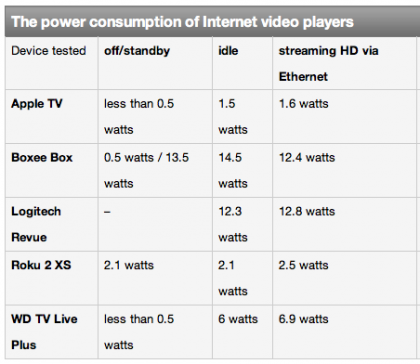A recent study concluded that many DVR and set-top box configurations are saddled with energy requirements that exceed those of “a new refrigerator and even some central air-conditioning systems.” Which does seem somewhat extreme when presented in that fashion. Of course, given all my gadgets, I’m sure I exceed my fridge’s estimated annual energy usage (615 kWh). In fact, a few years back we took a Kill A Watt around the house to get a read on the energy vampires… And, sure enough, my Series 3 TiVo was the worst offender – drawing 42 watts.
In response to this new report, GigaOm wondered how current streaming alternatives fair and enlisted a Belkin Conserve energy monitor to put several recent players to the test (see above). As you might expect the diminutive Apple TV and Roku were the most miserly in their wattage consumption. Although, Roku doesn’t have much in the way of a standby mode – drawing measurable power 24/7. The larger and more powerful (on paper) Logitech Revue and Boxee Box draw considerably more power, yet still clock in significantly less than a hard-drive-spinning DVR.
Interestingly, as our home entertainment configurations evolve, my iPad will essentially replace both a television and set-top box… providing not only newfound convenience but also the benefit of energy conservation.

“my iPad will essentially replace both a television and set-top box… providing not only newfound convenience but also the benefit of energy conservation.”
You can also store your iWater in the new iFridge app for iPad, and thus replace yet another energy eating appliance…
I am surprised that you didn’t mention the Premiere, which does significantly better than your Series3 at about 25 watts (at least it is definitely less than a refrigerator).
https://zatznotfunny.com/2010-03/digging-deeper-within-the-new-tivo-premiere/
Josh
Yeah, I posted and was going to followup with a comment up after my commute but you guys are too quick. :) That was one of two points. The other point was that even though the S3 was 42 watts, it was still less than most of the competing HD DVRs of the time. (The TiVo HD clocked in at about 38.)
I need to look into some of these smart powerstrips that turn off other components – for example, when I shut the TV off my Xbox and Roku should receive zero power as well but the FiOS DVR should remain on.
But I’m mostly done with fluorescent bulbs. It’s hit or miss which come on fast, which don’t. The colors also seem variable. And then there’s dimming issue. But the bigger negative may be the fact that they burn out even though they’re supposed to last years upon years. Maybe it’s the wiring in my house or maybe the longevity benefit is oversold. Either way, we’re going back to mostly incandescent in several locations. (At least until LED comes down.)
“Either way, we’re going back to mostly incandescent in several locations. (At least until LED comes down.)”
I’m very pro-incandescent. It’s the HD of light sources.
I’ll make trade-offs to lower my energy bill and carbon footprint, but there is lower-hanging fruit out there in terms of cost/value from my POV…
How does Boxee Box end up using more power when IDLE than when in use streaming???
I think the study was trying to get folks to turn off more powr consumption and went way over the top in the hype. Makes me wonder about all the numbers being correct or not.
That said, doing things like a power strip that can stop power flow to the Xbox and streaming devices that do not need to be on 24/7 can save some real energy especially when multiplied by a lot of households. Howevr you get back to the Off/ON mini power surge in the components that can hammer any weak spot in the circuits. same issue with Flourescents – they really are about lights that are left on the biggest part of the day and not getting a lot of off then on as well.
The DVR boxes are never really going to get any better until they somehow get smarter, turn completely off when not planning a recording and then turning back on just before. At that point, however, they would most likely need to have SSD memory instead of a spinning platter (sounds pretty cool actually) or maybe it simply turns on to a remote disk on the LAN which is more energy efficient and records to that. I don’t even want to KNOW how much energy my two D* HDTIVO’s consume, but I know in the home (with about 6 full time running computers, one fridge I never fall below 9 kwh when away.
the greatest “OFF” offender is the PS3
IT would be very easy to turn off the TIVO live TV buffer. At least an option for the user.
Glad to hear that the TiVo Premiere is reasonable in its consumption. Frankly, though, the biggest heat generator in my component stack tends to be the cable-deassifier, aka the Cisco SDV tuning adapter. I would love to be able to ditch this disaster, since I assume it’s sucking watts like crazy.